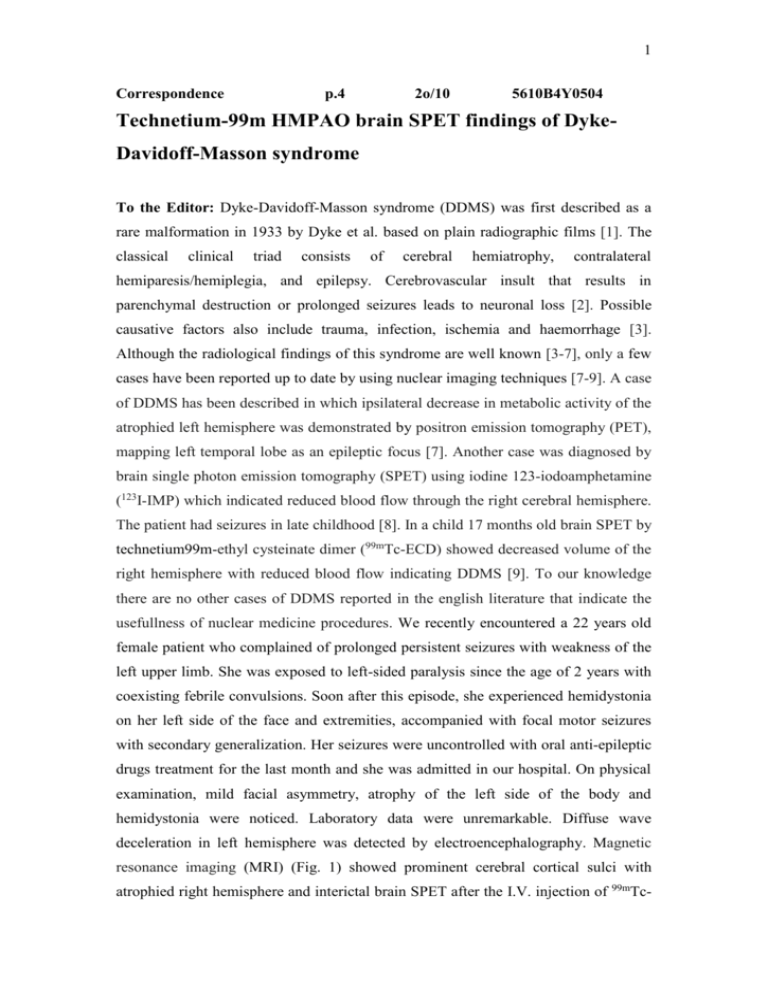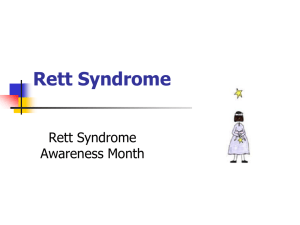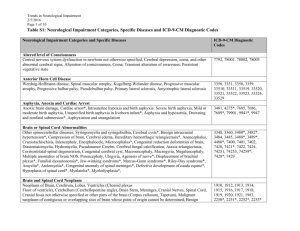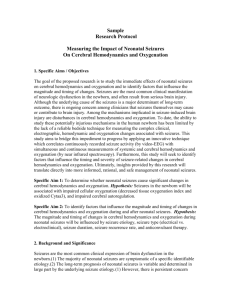Correspondence
advertisement

1 Correspondence p.4 2o/10 5610B4Y0504 Technetium-99m HMPAO brain SPET findings of DykeDavidoff-Masson syndrome To the Editor: Dyke-Davidoff-Masson syndrome (DDMS) was first described as a rare malformation in 1933 by Dyke et al. based on plain radiographic films [1]. The classical clinical triad consists of cerebral hemiatrophy, contralateral hemiparesis/hemiplegia, and epilepsy. Cerebrovascular insult that results in parenchymal destruction or prolonged seizures leads to neuronal loss [2]. Possible causative factors also include trauma, infection, ischemia and haemorrhage [3]. Although the radiological findings of this syndrome are well known [3-7], only a few cases have been reported up to date by using nuclear imaging techniques [7-9]. A case of DDMS has been described in which ipsilateral decrease in metabolic activity of the atrophied left hemisphere was demonstrated by positron emission tomography (PET), mapping left temporal lobe as an epileptic focus [7]. Another case was diagnosed by brain single photon emission tomography (SPET) using iodine 123-iodoamphetamine (123I-IMP) which indicated reduced blood flow through the right cerebral hemisphere. The patient had seizures in late childhood [8]. In a child 17 months old brain SPET by technetium99m-ethyl cysteinate dimer (99mTc-ECD) showed decreased volume of the right hemisphere with reduced blood flow indicating DDMS [9]. To our knowledge there are no other cases of DDMS reported in the english literature that indicate the usefullness of nuclear medicine procedures. We recently encountered a 22 years old female patient who complained of prolonged persistent seizures with weakness of the left upper limb. She was exposed to left-sided paralysis since the age of 2 years with coexisting febrile convulsions. Soon after this episode, she experienced hemidystonia on her left side of the face and extremities, accompanied with focal motor seizures with secondary generalization. Her seizures were uncontrolled with oral anti-epileptic drugs treatment for the last month and she was admitted in our hospital. On physical examination, mild facial asymmetry, atrophy of the left side of the body and hemidystonia were noticed. Laboratory data were unremarkable. Diffuse wave deceleration in left hemisphere was detected by electroencephalography. Magnetic resonance imaging (MRI) (Fig. 1) showed prominent cerebral cortical sulci with atrophied right hemisphere and interictal brain SPET after the I.V. injection of 99mTc- 2 hexamethylpropylene amine oxime (99mTc-HMPAO) which demonstrated the asymmetry of the hemispheres with global decrease of perfusion of the right hemisphere (Fig. 2). Marked decrease in activity was identified in the right parietal and temporal regions. Left lateral ventricle was also dilated. Brain SPET with 99m Tc HMPAO determined in DDMS the extent of cerebral hypoperfusion. The incidence of DDMS is at present unknown [10], but rare [7-9]. Figure 1. MRI of the brain, T1 inversion recovery imaging (A) and T2 coronal imaging (B) revealed atrophy of the right hemisphere with compensatory enlargement of the right lateral ventricle. 3 Figure 2. The assessment of the transaxial, coronal and sagittal brain SPET images demonstrated the asymmetry of the hemispheres with global decrease of perfusion of the right cerebral hemisphere. The dilatation of the left lateral ventricle was also seen. Bibliography 1. Dyke CG, Davidoff LM and Masson CB. Cerebral hemiatrophy and homolateral hypertrophy of the skull and sinuses. Surg Gynecol Obstet 1933; 57: 588-600. 2. Dix JE, Cail WS. Cerebral hemiatrophy: classification on the basis of MR imaging findings of mesial temporal sclerosis and childhood febrile seizures. Radiology 1997; 203: 269-74. 3. Tasdemir HA, Incesu L, Yazicioglu AK et al. Dyke-Davidoff-Masson syndrome. Clin Imaging 2002; 26: 13-7. 4. Aguiar PH, Liu CW, Leitao H et al. MR and CT imaging in the Dyke-Davidoff-Masson syndrome. Report of three cases and contribution to pathogenesis and differential diagnosis. Arq Neuropsiquiatr 1998; 56: 803-7. 5. Atalar MH, Icagasioglu D, Tas F. Cerebral hemiatrophy (Dyke-Davidoff-Masson syndrome) in childhood: clinicoradiological analysis of 19 cases. Pediatr Int 2007; 49: 70-5. 6. El Bahri-Ben MF, Mrabet H, Ben SR, Mrabet A. Dyke-Davidoff-Masson syndrome: a report of two cases. J Neuroradiol 2005; 32: 50-3. 7. Ono K, Komai K, Ikeda T. Dyke-Davidoff-Masson syndrome manifested by seizure in late childhood: a case report. J Clin Neurosci 2003; 10: 367-71. 8. Kulkarni K, Sperling MR, Intenzo C. Positron emission tomography in Dyke-Davidoff-Masson syndrome. Clin Nucl Med 2005; 30: 625-7. 9. Lee JH, Lee ZI, Kim HK, Kwon S. A case of Dyke-Davidoff-Masson syndrome in Korea. Korean J Pediat. 2006; 49: 208-11. 10. Bissonnette B, Luginbuehl I, Marciniak B, Dalens B. eds. Syndromes: Rapid recognition and perioperative implications. 1st edition. McGraw-Hill; New York. 2006; 253 Feyza Sen1, Mehmet Cabuk2, Duygu Yoruk Atik2, Aysun Unal3 1. Department of Nuclear Medicine, Faculty of Medicine, Uludag University, Bursa, Turkey 2. Departments of Nuclear Medicine and 3. Neurology, Medical School Zonguldak Karaelmas University, Zonguldak, Turkey Feyza Sen, MD 4 Department of Nuclear Medicine, Faculty of Medicine, Uludag University 16100 Gorukle, Bursa, Turkey Tel:+90.224.2953450 Fax:+90.224.4429212 E-mail: drfeyzasen@yahoo.com, feyzasen@uludag.edu.tr Hell J Nucl Med 2010;









